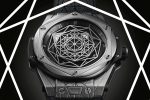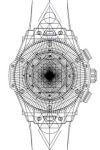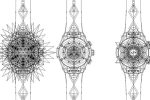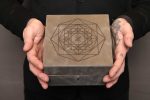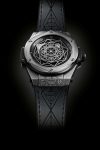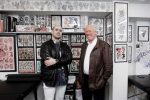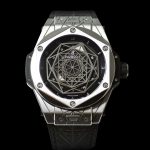Hublot
Sacred Geometry
Hublot
Sacred Geometry
But our tale has to begin in 16th-century France, with the followers of John Calvin, the man who broke from Catholicism in the 1530s, attacking the assertion that the institution was necessary for salvation by God. The French Huguenots adopted the reformed traditions Calvin espoused and as a result were harassed, imprisoned and killed over two centuries, forcing them – many of whom were members of the French watch industry – to set about establishing their own churches and communities in the French-speaking region of Switzerland.
Because their artistic voices were in some ways muted by their religion, they sublimated their creativity into two fields. The first was, naturally enough, watchmaking; the second was typography, where they would pour their inner artistry into the creation of fonts and – although they didn’t have a name for it yet – “graphic design”.
The Artist’s Crusade
According to Swiss tattoo artist Maxime Büchi, who trained at the prestigious Ecole Cantonale D’Art de Lausanne: “It’s for this reason that graphic design is such a respected craft in Switzerland. Because it’s something as a nation we’ve done for centuries. And when we learn to design, a central focus is typography.” After his studies, Büchi worked as a graphic artist and typographer but found himself leaning more and more to an art form that was on the cusp of becoming the single most popular medium in modern culture: tattooing.
The past three decades has seen the transformation of tattooing from a back alley profession that was the domain of outlaw motorcycle clubs and lifelong sailors to an extraordinarily lucrative medium that has influenced many aspects of modern life. Italian couture leather house Berluti has produced leather blousons emblazoned with designs by tattoo artist Scott Campbell; London-based tattoo legend Mo Coppoletta is creating custom interiors for Rolls-Royce; tattooists are the subject of endless television programmes, with artists like Kat Von D becoming insta-celebrities.
Old school artist Don Ed Hardy has cashed in by selling his name to a company that’s littered the world with garish T-shirts under the brand “Ed Hardy”. Moreover, it seems there is not a single NBA star, UFC star, celebrity chef or popular music figure who is without a tattoo. Yes, tattoos are everywhere, including Switzerland’s most hallowed watch manufactures. Revolution’s good friend Christian Selmoni, Vacheron Constantin’s Artistic Director, recently got his first sleeve – at the age of 50.
And as such Büchi soon found himself seeking out a mythical figure among tattoo artists: Filip Leu. Part shaman, part Obi-Wan, part Siddhartha Gautama, Leu’s parents established Switzerland’s
pre-eminent tattoo firm, the Leu Family Iron. in 1982. A “tattoo prodigy”, by 13 Leu was working regularly as a tattooist at his parent’s atelier and, by 18, he would be considered the tattoo world’s first bonafide superstar. “I was very lucky that Filip took me in as an apprentice,” says Büchi. “I owe my entire education in tattooing to him and it was an extraordinary experience, like learning to sculpt or paint from Michelangelo.”
To the Letter
But how would a tattoo artist and a watch CEO realign and unite the disciplines of typography and watchmaking that defined Switzerland in a single timepiece?
It dawned on Guadalupe when he was sitting by a swimming pool in Los Angeles that in all modern communities there were more tattooed people than people without tattoos. “It makes fine art relevant to a whole new generation,” he says. And he’s got a point. Ask any young person if they might be interested in a retrospective on Russian Suprematism, Italian Futurism or Fauvism and many will beat a hasty retreat. Yet ask them if they’re interested in artists like Büchi who were deeply influenced by art, culture, mathematics and they’ll invariably say yes.
“We recognised that tattooing was a new universe,” says Guadalupe. “Tattoos are probably the most contemporary and highly-communicated art form today and if we knew if we were to collaborate with one of the world’s best like Maxime, it could connect us to a world of tattoo aficionados who might not be aware of us. At the same time, the objective was to also show a different side of tattooing, to show the artistic, intellectual and creative process behind this art form. So we knew immediately if we were going to make a tattoo-inspired watch, it had to be one like nothing seen before.”
The Right Lines
What is Büchi’s tattooing about then? As with most great artists, it is hard to explain, but here goes. Büchi creates incredibly vivid tattoos with sharp, clean lines that can be figurative or geometric/abstract. His figurative work is informed by ancient printing techniques; however, it is through the creative, almost spontaneous manipulation of these lines to create density, texture, volume and shape that Büchi’s work is particularly breathtaking.
Then there are Büchi’s geometric tattoos, which are perhaps even more interesting because, he explains, this geometric language has its roots in the same Protestant exodus that created the Swiss watch industry. “Our idea was to integrate this geometric tattoo motif into the time-telling indicators and, in so doing, re-interpret the way time is expressed,” he explains. “So what we did was create a system of discs – the smallest in the centre to show the passing of the seconds, the next one to show the minutes and the outermost to show the hours.
“I created a linear design based on what is called ‘sacred geometry’, which is geometric shapes and patterns that are inspired by artistic motifs we might see in religious art or architecture. Because I’m Swiss, I know the history of Protestantism and because they were not allowed painting in their churches, they focused a lot of their creative energy on the typography in their texts. I would look at this typography to gain inspiration for tattooing.”
Büchi continues: “Every part of the design is inspired by the Big Bang’s shape. Interestingly, I got to the trapezoid-shaped pushers that are for the strap quick release and realised the pattern I was creating perfectly echoed the shape of this element, so it integrates into it organically. I specialise in understanding the best placement of a specific design on a specific part of the body, so I was extremely careful to ensure that this is a design that looks particularly beautiful on the wrist. What’s amazing is that each time I asked Hublot if we could go a step further, instead of saying ‘no’, they encouraged me.”
Tomorrow Belongs to Hublot
When asked if it is part of the strategy to use motifs like camouflage or tattooing to reach the younger audience, Guadalupe nods. “What is incredibly important is we connect not just with the customer of today but the customer of tomorrow. We are thrilled when young people who may not be in a position to buy our watches today come into the store or respond to our Instagram page. [Hublot was the first Swiss luxury watch brand with an Instagram page and is still the most popular, with 1.1 million followers.]”
As for the finished product, Büchi is almost without words. “I am overwhelmed,” he admits. “As a watch collector, specific brands make an impression on me – some classic, some modern, but always the ones I find most authentic. I am successful enough that I don’t have to do these collaborations, so when I enter into a partnership, it’s because I like the people I’m working with and I respect what they do. This entire process has been amazing because of the creative flexibility and ambitions of Hublot. To see this watch now – a model made by one of my favourite brands but re-imagined by me – is seriously a dream come true.”
The 45mm titanium Hublot Big Bang Sang Bleu is a limited edition of 200.
Read our unveiling story of the Big Bang Sang Bleu, from New York.




